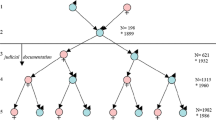Abstract
The effect of a target person’s familial relationship with a convicted criminal on the impressions of the target was examined. Participants rated an individual who had either no relative in prison (control), or a cousin, brother or identical twin brother serving a prison sentence for burglary and armed robbery. The target person had no criminal background. Ratings of the target were lower in the three “relative in prison” conditions, as compared to the control condition. Ratings of the target decreased as kinship with the criminal increased, with the exception of the “identical twin” condition, which was approximately equal to ratings provided by participants in the control condition. The results suggest that participants actively evaluated the extent of the familial relationship between the target person and the criminal relative and used this information in the impression formation process.
Similar content being viewed by others
References
Asch, S. E. (1946). Forming impressions of personality. Journal of Abnormal and Social Psychology, 41,258–290.
Brewer, M. B. (1979). In-group bias in the minimal intergroup situation: A cognitive-motivational analysis. Psychological Bulletin, 86, 307–324.
Brewer, M. B. (1988). A duel process model of impression formation. In T. K. Srull & R. H. Wyer (Eds.), Advances in social cognition (Vol. 1, pp. 1–36). Hillsdale, NJ: Earlbaum.
Byrne, D. (1961). Interpersonal attraction and attitude similarity. Journal of Abnormal and Social Psychology, 62,713–715.
Darley, J. D., & Gross, P. H. (1983). A hypothesis-confirming bias in labeling effects. Journal of Personality and Social Psychology, 44,20–33.
Dion, K. K., Berscheid, E., & Walster, E. (1972). What is beautiful is good. Journal of Personality and Social Psychology, 24, 285–290.
Eagly, A. H., Ashmore, R. D., Makhijani, M. G., & Longo, L.C. (1991). What is beautiful is good, but...: A meta-analytic review of research on the physical attractiveness stereotype. Psychological Bulletin, 110, 109–128.
Fiske, S. T., & Neuberg, S. L. (1990). A continuum of impression formation, from category-based to individuating processes: Influences of information and motivation on attention and interpretation. In M. P. Zanna (Ed.), Advances in experimental social psychology (Vol. 23, pp. 1–74). San Diego: Academic Press.
Ganong, L. H., & Coleman, M. (1997). Effects of patient marital status and parental status on nurses' cognitions and behaviors. Journal of Family Nursing, 3,15–21.
Govern, J. M., & Greco, M. (2000). Accused criminals are innocent until proven guilty: Don't remind me. Manuscript in preparation.
Guttman, J., Geva, N., & Gefen, S. (1988). Teachers' and school children's Stereotypic perception of “the child of divorce.” American Educational Research Journal, 25,555–571.
Kenny, D. A., & Kashy, D. A. (1994). Enhanced co-orientation in the perception of friends: A social relations analysis. Journal of Personality and Social Psychology, 67, 1024–1033.
Kramer, G. P., Kerr, N. L., & Carroll, J. S. (1990). Pretrial publicity, judicial remedies, and jury bias. Law and Human Behavior, 14,409–438.
LeVine, R. A., & Campbell, D. T. (1972). Ethnocentrism: Theories of conflict, ethnic attitudes and group behavior. New York: Wiley.
Mae, L., Carlston, D. E., & Skowronski, J. J. (1999). Spontaneous trait transference to familiar communicators: Is a little knowledge a dangerous thing? Journal of Personality and Social Psychology, 77, 233–246.
Moran, G., & Cutler, B. L. (1991). The prejudicial impact of pretrial publicity. Journal of Applied Social Psychology, 21,345–367.
Newcomb, T. (1961). The acquaintance process. New York: Holt, Rinehart & Winston.
Otto, A. L., Penrod, S. D., & Dexter, H. R. (1994). The biasing impact of pretrial publicity on juror judgments. Law and Human Behavior, 18,453–469.
Rosenthal, R. & Jacobson, L. (1968). Pygmalion in the classroom. New York: Holt, Rinehart & Winston.
Sedikides, C., Olsen, N., & Reis, H. T. (1993). Relationships as natural categories. Journal of Personality and Social Psychology, 64,71–82.
Schneider, M., Tanke, E. D., & Berscheid, E. (1977). Social perception and interpersonal behavior: On the self-fulfilling nature of social stereotypes. Journal of Personality and Social Psychology, 35,656–666.
Sigall, H., & Landy, D. (1973). Radiating beauty: Effects of having a physically attractive partner on person perception. Journal of Personality and Social Psychology, 28, 218–224.
Skowronski, J. J., Carlston, D. E., Mae, L., & Crawford, M. T. (1998). Spontaneous trait transference: Communicators take on the qualities they describe in others. Journal of Personality and Social Psychology, 74, 837–848.
Sue, S., Smith, R. E., & Gilbert, R. (1974). Biasing effect of pretrial publicity on judicial decisions. Journal of Criminal Justice, 2, 163–171.
Tans, M., & Chaffee, S. (1966). Pretrial publicity and juror prejudice. Journalism Quarterly, 43, 647–654.
Author information
Authors and Affiliations
Corresponding author
Additional information
The authors thank Melissa Fuller, Emily Ganz, Michelle Kitts, Michelle Offsie and Kimberly Watson for their assistance in data collection and data entry and Herbert Petri for his comments on an earlier draft of this manuscript.
Rights and permissions
About this article
Cite this article
Govern, J.M., Greco, M. Evidence for the “guilt by familial association” effect: Evil twins excepted. Curr Psychol 21, 213–219 (2002). https://doi.org/10.1007/s12144-002-1014-y
Accepted:
Issue Date:
DOI: https://doi.org/10.1007/s12144-002-1014-y




